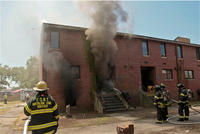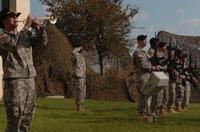-
Using cold plasma to fight fires
Traditional fire-suppression technologies focus largely on disrupting the chemical reactions involved in combustion; from a physics perspective, however, flames are cold plasmas; DARPA, the Pentagon’s research arm, theorized that by using physics techniques rather than combustion chemistry, it might be possible to manipulate and extinguish flames
-
-
FDNY conducts live fire tests to test improvements in fire department tactics

In the name of science, but with aim of saving lives, preventing injuries, and reducing property losses, members of the New York City Fire Department (FDNY) spent much of the first two weeks in July setting fire to twenty abandoned townhouses on Governors Island, about a kilometer from the southern tip of Manhattan
-
-
TeleCommunication Systems acquires next-generation 9-1-1 technology specialist microDATA GIS
The Federal Communications Commission (FCC) predicts that state and local governments will spend up to $1.2 billion over the next ten years for NG9-1-1 upgrades, with an additional $1.5 billion spent on recurring connectivity, hosting, and operations and maintenance; TeleCommunication Systems acquires microDATA GIS, a next-generation 9-1-1 technology specialist
-
-
Fort Hood incident report calls for sweeping changes in FBI’s approach

A report of the 2009 Fort Hood shooting will recommend eighteen specific changes which will make the FBI more likely to detect such insider threats earlier; the report, written by William Webster, the former director of the FBI, will be on the desk of Robert Mueller, the current FBI director, next week; the report’s authors focused on the FBI and the agency’s more than a hundred Joint Terrorism Task Forces (JTTFs) and how they handled and acted on counterterrorism intelligence before and after the shootings … and the FBI’s remedial measures in the aftermath of Fort Hood
-
-
NYPD AW119 fleet achieves 20,000 hour milestone
The NYPD has four AW119 helicopters in service; the department’s first AW119 entered service in 2004; the NYPD has become the worldwide law enforcement fleet leader, having achieved more than 20,000 flying hours on the fleet
-
-
Feds give Colorado access to critical infrastructure info
The Homeland Security Infrastructure Program (HSIP) compiles about 500 layers of geographic features, including power plants and water pumps; it is managed by DHS, the Pentagon’s National Geospatial Intelligence Agency, and the U.S. Geological Survey; the data set is available to state first responders only when federal disasters are declared; DHS has now given Colorado access to the HSIP
-
-
Bomb threat? There’s an app for that

In the first chaotic moments after suspicion of a bomb threat, first responders have a myriad of questions, assessments, and decisions to make, all at once, and all the while the scene could be changing rapidly: Is the bomb real? How large is the potential blast radius? Where will we evacuate people? Are there any critical infrastructure or special-needs population centers in the vicinity? Any schools, hospitals nearby? What roads should be closed? Which roads should stay open for evacuees? There are many more questions, many more uncertainties; DHS Science and Technology Directorate (S&T) and its private sector partners have now developed a must-have app: the First Responder Support Tools (FiRST) for computers and smartphones
-
-
Clay-based coating holds promise of green flame retardants
The thick, fast-forming coating has a uniformly high concentration of flame-inhibiting clay particles, and it adheres strongly to the Swiss cheese-like surface of polyurethane foam, which is used in furniture cushions, carpet padding, children’s car seats, and other items
-
-
Container ships as offshore platforms for direct support to disaster zones
DARPA’s Tactically Expandable Maritime Platform (TEMP) program has completed the design of technologies to transform commercial container ships into self-contained floating supply bases during disaster relief operations, without needing port infrastructure
-
-
Mega-quake hotspots around the world

The 2010 earthquake in Haiti killed hundreds of thousands and destroyed large sections of the capital, Port au Prince; the clock is ticking on many earthquake faults throughout the world, and a comprehensive new book points to places around the world that could face the fate of Port au Prince
-
-
Safety profiles protect people, pets, and emergency responders
Sixty-three percent of all U.S. households have a pet, the highest level in two decades; there are 78.2 million dog and 86.4 million cat owners, with more than half stating they would leap into action for an injured pet; registering pets in the owner’s safety profile would allow for safer, and more successful, rescue by first responders during emergencies
-
-
Rescue dogs from across U.S. to participate in certification exercise
Rescue dogs and their handler teams must be re-certified every three years; the certification includes command control, agility tests, barking alert skills, and willingness to overcome fears of tunnels and wobbly surfaces under the guidance of the handler
-
-
Private, public partners in Illinois CBRN emergency drill
First responders and authorities in Lake and Cook counties, Illinois, joined Army Reserve units to conduct Exercise Red Dragon 2012, a chemical, nuclear response exercise
-
-
Harris awarded DHS communications contract with a $3 billion potential value
Harris has been awarded a 5-year, IDIQ DHS contract to support tactical communications for the U.S. Department of Homeland Security and its partner agencies; the contract has a $3 billion ceiling
-
-
Space Data, partners test high-altitude disaster communication
Since 2004, Space Data has logged more than 250,000 flight hours in near space altitudes between 65,000 and 90,000 feet in conducting more than 20,000 flights of its balloon-borne platforms; near space technology has become a critical communications relay capability for the U.S. military, particularly for deployed forces overseas; the FCC wants this technology to be available for first responders
-
More headlines
The long view
The Surprising Reasons Floods and Other Disasters Are Deadlier at Night
It’s not just that it’s dark and people are asleep. Urban sprawl, confirmation bias, and other factors can play a role.
Why Flash Flood Warnings Will Continue to Go Unheeded
Experts say local education and community support are key to conveying risk.
